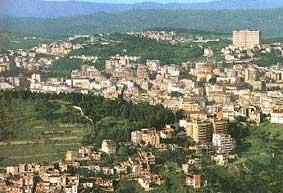


All the structures

The information about the origins of Nuoro is uncertain. The first settlements around the site where the city was built date from the Nuraghic Age, as some place names and the existence of a number of nuraghi, domus de Janas (chamber tombs) and sacred wells attest.
Nuoro maintains its natural environment in excellent condition: unpolluted forests, Mediterranean scrub and unspoiled landscapes dominate the whole province. Most of Nuoro’s lands are used for pasture.
The central part of the Nuoro province is called the Nuorese. The other areas of the province are the Baronies of Siniscola and Orosei, Ogliastra, the Barbagie of Ollolai, Belvì, Seulo, Sarcidano in the south, and Marghine and Planargia.
Nuoro city is situated on a plateau surrounded by mountains.
Nuoro’s mountain is the much-visited Ortobene, which offers visitors views of great emotional impact over forests, mountains and the sea!
The village of Lollove is worth visiting. This tiny town is inhabited by very few families and has a warm, welcoming atmosphere. Among the small homes are ruins and a wonderful 17th century church. To make a visit to Lollove even more intriguing, legend tells that when some nuns ran away to hide their carnal relationship with the village shepherds, they cursed the town by saying, "You will be like the water of the sea: you will neither grow nor die."
Aritzo, dominated by a natural stone tower, is another splendid village. The tower is an unusual mushroom shape. Aritz has always been called the "snow town" and has the delicious tradition of producing nougat.